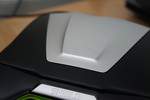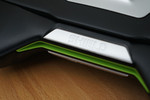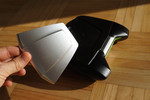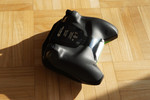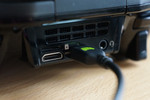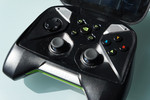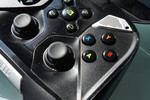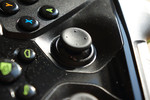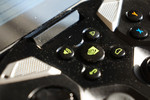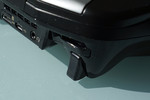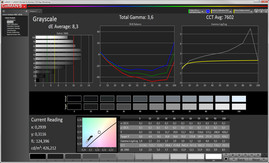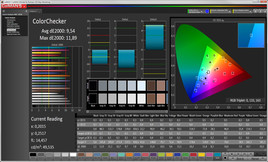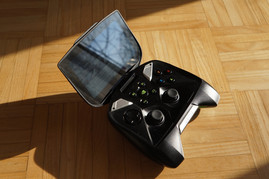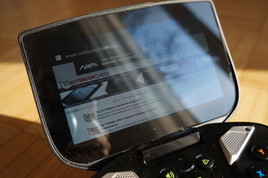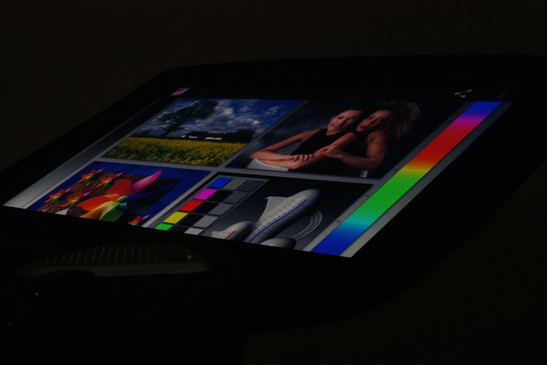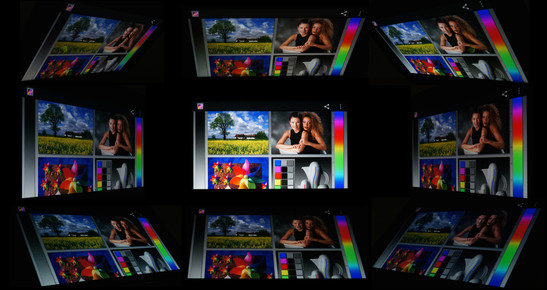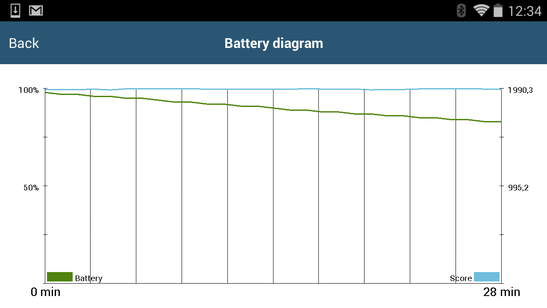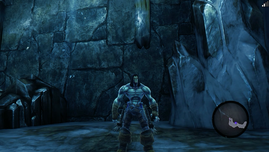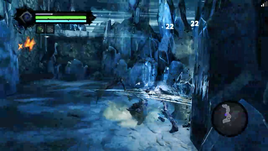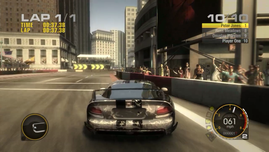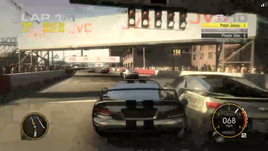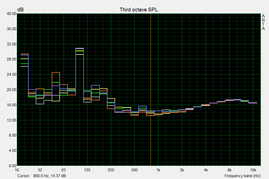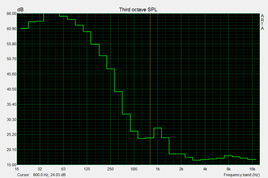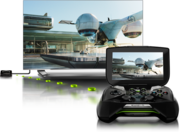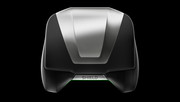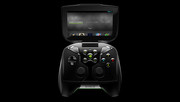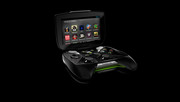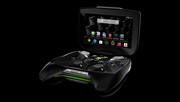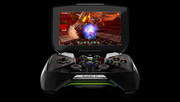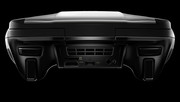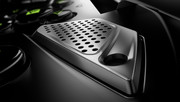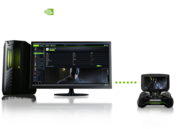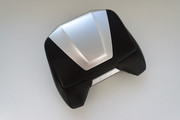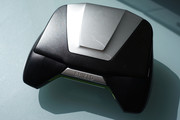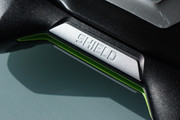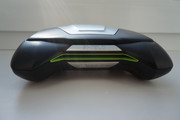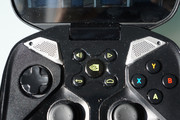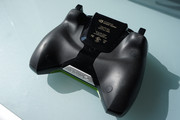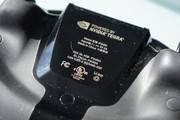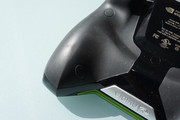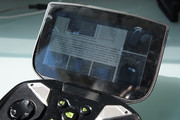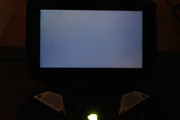Review NVIDIA Shield Portable Handheld
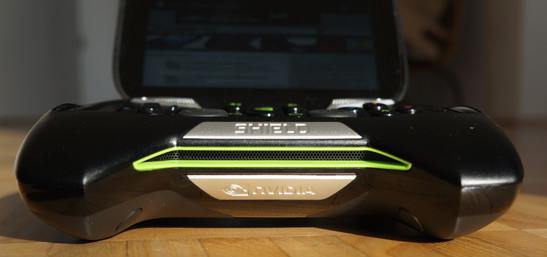
Now almost a year old, the Nvidia Shield handheld was admittedly a tough recommendation at launch due to a variety of factors. It suffered from many of the same problems as new console releases including high costs ($300 USD at launch) and a limited library of games that can take full advantage of the hardware and features.
Fast forward to GTC 2014, however, and the landscape has changed considerably for the Shield platform. The device has now been updated to Android KitKat (4.4.2) and, as of Software Update 65, now supports both Nvidia's GRID and GameStream platforms for on-demand cloud gaming and PC streaming, respectively. Perhaps most importantly, the device has received a much needed $100 price cut for a more reasonable MSRP of $200 in the U.S. to better compete with tablets and the similarly priced Nintendo 3DS and PS Vita.
In this review, we put the Shield through our usual bouts of hardware tests and play with some of the newer and more enthralling features of the software suite. So, what exactly does this Nvidia handheld offer that you can't get from a standard Android tablet or Sony or Nintendo equivalent?
Case
Imagine an Xbox 360 controller with a flip top LCD display and you have a rough idea of the shape and design of the Shield. The chassis is built for comfortable two-handed operation and it fulfills the role exceptionally well. The rubberized back provides a firm grip while the glossy edges and matte plastic gamepad feel pleasant to use even after extended periods. Surfaces feel thick and rigid with no visible gaps or noticeable manufacturing defects on our test model. iFixit rates the Shield a 6/10 for repairability and claims that the battery is not easy to replace, but that the case can still be opened quickly for cleaning purposes.
Additionally, while the rubber, glossy and matte materials blend well together for an appealing jet black product, the glossy areas succumb quickly to scratches and scuffs. The rear ports, for example, are prime examples as users will be connecting metal USB, audio and HDMI cables that can scratch the glossy surface surrounding the ports. On the other hand, the matte rubber back and plastic front do a very good job at hiding fingerprints and resisting scratches and show almost no signs of aging due to regular use.
The weight of the device is relatively heavy at 579 grams, which is noticeably heavier than other handheld gaming systems, console controllers (three times heavier than a DualShock 3) and even 7-inch tablets currently in the market. To its defense, the Shield carries a dense 28.8 Wh battery that is much larger than competing handheld gaming systems and most 7-inch tablets, including the second generation Nexus 7.
The single hinge design allows the display to open 180 degrees for a wider range of comfortable viewing angles. We did experience minor creaking in some situations, but the hinge holds the display firmly in place with no issues nonetheless. This is especially important as the device should be used in landscape mode only as portrait mode is simply impractical due to the unique symmetry and weight distribution of the Shield. Nvidia is well aware of this, of course, and has disabled auto-rotation in the Settings menu by default.
The Shield namesake doesn't have its roots to the Marvel Universe, but instead references the customizable "Armor" plating that sits on the outer lid. The default silver plastic plating is attached to the matte black lid by magnets and can be easily removed and replaced with other Armors of different designs. Nvidia showed off a few of their own at GTC 2014 including glossy black and carbon fiber Armors to be available soon for $20 apiece. These Armors are not essential to the build quality or functionality of the device and serve more as end-user customization options than anything else, so the $20 asking price is a bit pricey for a simple aesthetic change. Luckily, we found the default silver Armor just fine and a fitting contrast to the black design.
The case as a whole leaves a very positive impression with no noticeable warping from pressure or side-to-side twisting. Especially from a manufacturer of primarily GPUs, the workmanship and quality of the Shield sits comfortably with other well-known handheld gaming devices at the expense of some added heft.
Connectivity
As is typical of tablets and handhelds, the connectivity options of the Shield are somewhat limited. With that said, the available MicroSD slot, mini HDMI-out, micro USB 2.0 and 3.5 mm headset ports should be sufficient for the target audience. All ports are located on the rear at close proximity to one another. Though they are all easily accessible, the microSD slot is a bit too close to the HDMI port, so cards may be difficult to insert or remove if an HDMI cable is connected.
The integrated microphone works well for Skype calls but is mediocre for proper landline or cellphone calls. Note the complete absence of webcams; video conferencing or picture taking are beyond the scope of this handheld. Meanwhile, the HDMI port works flawlessly and will output to a default 1280 x 720 resolution. If in Console Mode, the internal display will deactivate and the external will change to a native 1920 x 1080 output.
As for the sole USB 2.0 port, the connector will be used mainly for charging, but we were also able to connect generic plug-and-play flash drives, mice and keyboards without any issues. As of the April 7th update, Bluetooth mice and keyboards are also compatible with streaming games, too. This is a definite boon for any gaming device.
Communication
The Shield comes with an integrated 2x2 (2.4 and 5 GHz) 802.11 abgn WiFi module that offers stable connections in our tests. Bluetooth 4.0 and GPS are supported as well. There is no IR blaster or receiver, however, which could have turned the handheld into a much more capable multimedia controller.
Warranty
Nvidia offers the standard one-year limited warranty in the U.S. that covers repairs and replacement of defective units and accessories. More information on the warranty can be found here.
Input Devices
Gamepad
Great games can be quickly ruined by poor controls, so it's a safe bet to say that Nvidia had meticulously designed the handling and buttons to feel as natural, responsive and easy-to-use as possible. From short train rides to long flights, the gamepad generally feels good to use and should feel quite familiar to Xbox fans, albeit with some minor but important differences.
First, the directional pad and two analog sticks work well as to be expected, but are a bit on the small side compared to their home console counterparts. The analog sticks in particular suffer from a smaller range of movement as a result, so it is comparatively more difficult to make very precise movements in games.
The four shoulder buttons could use some improvement as well. L1 and R1 feel a bit too small with very little travel when depressed and the L2 and R2 trigger buttons can wiggle left and right quite easily and could have been made more rigidly.
The five center face buttons (Volume, Play, Back, Home, and Power) are the standard fare that most Android devices share. Unfortunately there are no dedicated Up/Down volume keys as the Volume button will simply open up an onscreen setting. Additionally, there are no dedicated buttons for brightness either. Pressing the Power button will open the Games Shop with titles ranging from free to $14.99 and up.
Holding down the same Power button will activate the all-important Gamepad mapper. This allows users to manually customize the buttons on an app-by-app basis. Thus, a game that may otherwise be touchscreen only will be suddenly playable with tactile buttons. This opens up a Pandora's Box of possibilities with regards to games on the Play Market. Worms 2: Armageddon, for example, suddenly becomes much easier and more fun to play with solid buttons. We expect users to become quite familiar with the Gamepad mapper as many available titles and software, such as Asphalt 8, do not fully support the gamepad by default.
What minor faults there are do not detract from the fact that the gamepad is overall very well made and comfortable to use. Navigating through Android menus even feels quite natural, though most common apps like Youtube or Google Maps are better off with standard touchscreen inputs. As good as the Shield controller may be, it falls a bit short compared to the Xbox 360 controller that it attempts to emulate.
Touchscreen
Touchscreen operations move swiftly with very minimal recognition problems - similar to a mainstream smartphone. Precision is not an issue and the screen managed to recognize 11 simultaneous fingers in our tests, which we imagine to be more than enough for any kind of scenario.
Instead, the main issue lies with the poor ergonomics of the touchscreen. The weight, shape and design of the Shield make touch-typing and scrolling more difficult and tedious than on a regular tablet or smartphone. The entire device is working against the user in this regard, so users will be better off web browsing or emailing elsewhere. Otherwise, the touchscreen functions just fine with no noticeable bugs.
Display
The 5-inch 1280 x 720 resolution (294 PPI) screen is standard in size compared to high-end Android smartphones like the HTC M8 or LG G2, but it simply does not match the higher 1080p displays and richer colors of those same examples. Furthermore, the bezel of the display is much larger than the bezels of smartphones, so there is still lots of room for increasing screen size without necessarily increasing the overall dimensions of the display. Regardless, the 720p resolution is sufficient as users will be holding the Shield a bit further away from the eyes compared to a smartphone.
An average brightness of almost 400 nits was measured across nine quadrants of the screen. Though the brightness distribution is not very good, the screen is very bright nonetheless and is comparable to high-end tablets and smartphones. Contrast is also excellent at well above 1000:1 for deeper blacks and less muddy grays in games and movies.
| |||||||||||||||||||||||||
Brightness Distribution: 79 %
Center on Battery: 432 cd/m²
Contrast: 1440:1 (Black: 0.3 cd/m²)
ΔE ColorChecker Calman: 9.5 | ∀{0.5-29.43 Ø4.77}
ΔE Greyscale Calman: 8.3 | ∀{0.09-98 Ø5}
Gamma: 3.6
CCT: 7602 K
We measured color reproduction with an X-Rite i1Pro 2 spectrophotometer and found colors to be generally inaccurate with poor grayscale. Blue in particular is off due to a cool color temperature and the average dE2000 deviation of 9.5 units is below average. Compared to the similarly priced Nexus 7, the Shield just cannot compete in color accuracy.
Fortunately, these display inaccuracies are hardly a deal breaker for the target gaming audience as fast response times and minimal ghosting are usually of higher priority. Even subjectively, any color inaccuracies are not all that noticeable during play. The high brightness and contrast still make the handheld a great fit for media playback despite these color shortcomings.
Outdoor use is made possible due to the high screen brightness at a high or maximum setting. Battery life, of course, will suffer as a result, but it is a fair tradeoff for the ability to play outdoors under sunlight without too much eyestrain. The 180 degree hinge allows for more freedom to reduce potential glare.
Note that the touchscreen raster of the display can be seen in brightly lit environments. While not overly distracting, it can be a bit annoying at first before becoming accustomed to its visibility overtime.
Performance
Being an Nvidia product, the Shield is a natural showcase for the manufacturer's latest mobile offering: the Tegra 4 APU. The processor here operates at a slightly higher clock than other Tegra 4 devices (1.9 GHz vs. 1.8 GHz) due the Shield's active cooling. Its Cortex-A15 architecture places the Tegra 4 in the same ballpark as the Snapdragon 800 in multi-core operations. Competing devices launching this year with the Snapdragon 801, such as the Samsung Galaxy S5 or HTC One M8, are expected to outperform the Tegra 4 by slight margins in certain areas.
In turn, the upcoming Tegra K1 will succeed the Tegra 4 when it launches late this year to better compete with Qualcomm, Apple and Samsung offerings. Otherwise, when combined with the 2 GB RAM, the Shield certainly carries the horsepower necessary to run common Android apps and browsers fluently.
Processor
The actively cooled Tegra 4 compares favorably against similar high-end ARM-based SoCs currently in the market. For example, overall scores in Geekbench 3 and 3DMark 2013 Physics are very similar to the Galaxy S5 despite the yearlong head start by the Shield.
Generally, the Nvidia SoC will slightly outperform a Snapdragon 800 in multi-core tests but run short in single-core tests. In contrast, the older Snapdragon 800 in the Nexus 5 trails the Nvidia handheld by as much as 50 percent in Geekbench 3 and AndEBench benchmarks. The HTC One M8 trades blows with the Tegra 4 in some cases, but the results should be taken with a grain of salt since the Taiwanese manufacturer was recently caught manipulating their hardware for unfair advantages in certain benchmarks.
Note that AndEBench results are not as clear cut as the Shield pulls ahead in Java but loses out to the One M8 and Galaxy S5 in the Native portions of the benchmark. Regardless, the Tegra 4 is still very competitive against the latest 2014 releases.
| 3DMark - 1280x720 offscreen Ice Storm Unlimited Physics (sort by value) | |
| NVIDIA Shield | |
| HTC One M8 | |
| Samsung Galaxy S5 | |
| NVIDIA Note 7 | |
| Google Nexus 5 | |
| Wiko Highway | |
| Geekbench 3 | |
| 32 Bit Multi-Core Score (sort by value) | |
| NVIDIA Shield | |
| HTC One M8 | |
| Samsung Galaxy S5 | |
| NVIDIA Note 7 | |
| Google Nexus 5 | |
| Wiko Highway | |
| 32 Bit Single-Core Score (sort by value) | |
| NVIDIA Shield | |
| HTC One M8 | |
| Samsung Galaxy S5 | |
| NVIDIA Note 7 | |
| Google Nexus 5 | |
| Wiko Highway | |
Graphics Performance
The GeForce ULP graphics core of the Tegra APU continues to rely on fixed pixel and vertex shaders and a truly unified shader architecture will not come to the Tegra series until the arrival of the K1 platform. Thus, the graphics performance of the Nvidia's Tegra 4 is comparable to that of current high-end contenders and not much more.
In 3DMark 2013 and Basemark X 1.1, for example, the Shield performs very similarly to the Galaxy S5, though it does edge out the One M8 in certain cases. Some benchmarks like GFXBench 3.0 Manhatten simply do not run as the Nvidia SoC is only compatible with OpenGL ES 2.0. The older ARM Mali-450 MP4 GPU, such as in the Wiko Highway smartphone, is far behind in all benchmarks.
The Shield could still benefit from better graphics performance as we experienced hitches and minor slowdowns during more intense moments in Asphalt 8 and GTA 3. Gameplay is otherwise smooth the vast majority of the time.
Video playback of a sample 4K MP4 file encoded with H.264 appears smooth, though we did experience audio syncing issues when playing certain video files from a microSD card. By switching to software acceleration with a third party video player, however, the same video files would play problem-free.
| 3DMark - 1280x720 offscreen Ice Storm Unlimited Graphics Score (sort by value) | |
| NVIDIA Shield | |
| HTC One M8 | |
| Samsung Galaxy S5 | |
| NVIDIA Note 7 | |
| Google Nexus 5 | |
| Wiko Highway | |
| GFXBench (DX / GLBenchmark) 2.7 | |
| 1920x1080 T-Rex Offscreen (sort by value) | |
| NVIDIA Shield | |
| HTC One M8 | |
| Samsung Galaxy S5 | |
| NVIDIA Note 7 | |
| Google Nexus 5 | |
| Wiko Highway | |
| T-Rex Onscreen (sort by value) | |
| NVIDIA Shield | |
| HTC One M8 | |
| Samsung Galaxy S5 | |
| NVIDIA Note 7 | |
| Google Nexus 5 | |
| Wiko Highway | |
System Performance
Subjective system performance is fast and comparable to the Nexus 7 and more expensive smartphones when browsing the net. The update to Android 4.4 does help in certain areas, most notably in browser-based benchmarks like Peacekeeper as Chrome automatically updates to V34, but general performance differences are otherwise hard to notice. Pages still render as quickly as ever for a mobile device.
AnTuTu v4 and Quadrant 2.0 show conflicting results as the Shield pulls out noticeably ahead in the former against the Snapdragon 801 in the One M8 and Galaxy S5, but falls by as much as 20 percent in the latter benchmark.
| AnTuTu v4 - Total Score (sort by value) | |
| NVIDIA Shield | |
| HTC One M8 | |
| Samsung Galaxy S5 | |
| NVIDIA Note 7 | |
| Google Nexus 5 | |
| Wiko Highway | |
| Quadrant Standard Edition 2.0 - --- (sort by value) | |
| NVIDIA Shield | |
| HTC One M8 | |
| Samsung Galaxy S5 | |
| NVIDIA Note 7 | |
| Google Nexus 5 | |
| Wiko Highway | |
| Peacekeeper - --- (sort by value) | |
| NVIDIA Shield | |
| HTC One M8 | |
| Samsung Galaxy S5 | |
| NVIDIA Note 7 | |
| Google Nexus 5 | |
| Wiko Highway | |
| Octane V2 - Total Score (sort by value) | |
| NVIDIA Shield | |
| NVIDIA Shield | |
| HTC One M8 | |
| Samsung Galaxy S5 | |
| NVIDIA Note 7 | |
| Google Nexus 5 | |
| Google Nexus 5 | |
| Wiko Highway | |
Storage Devices
Flash storage performance according to AndroBench 3 shows nothing out of the ordinary. A notable exception is the Shield's random read rate of small 4 KB blocks, which handily tops all other smartphones in our comparison chart. The LG G2 is a notable outlier with sequential read speeds nearly twice as fast as the Nvidia handheld.
When compared to other mobile devices in the last 12 months, the Shield is marginally above average in AndroBench 3. Sequential read and write of 256 KB blocks are above the 55 MB/s and 12 MB/s averages, respectively, while random read of 4 KB blocks is above the average of 10.4 MB/s. Random write of 4 KB blocks is exactly average at 0.79 MB/s.
The integrated 16 GB internal eMMC SSD only offers 12.62 GB for immediate use, so users may find themselves running out of space quickly from installed games and movies. The MicroSD slot alleviates the storage ceiling, but high capacity cards may not function correctly. We inserted a 64 GB Samsung microSD for testing that was unfortunately not recognized by the device and the card even lost data in the process. A second 16 GB MicroSD card, however, worked without issues on our model.
| AndroBench 3-5 | |
| Sequential Read 256KB (sort by value) | |
| NVIDIA Shield | |
| HTC One M8 | |
| Samsung Galaxy S5 | |
| NVIDIA Note 7 | |
| Google Nexus 5 | |
| Wiko Highway | |
| Sequential Write 256KB (sort by value) | |
| NVIDIA Shield | |
| HTC One M8 | |
| Samsung Galaxy S5 | |
| NVIDIA Note 7 | |
| Google Nexus 5 | |
| Wiko Highway | |
| Random Read 4KB (sort by value) | |
| NVIDIA Shield | |
| HTC One M8 | |
| Samsung Galaxy S5 | |
| NVIDIA Note 7 | |
| Google Nexus 5 | |
| Wiko Highway | |
| Random Write 4KB (sort by value) | |
| NVIDIA Shield | |
| HTC One M8 | |
| Samsung Galaxy S5 | |
| NVIDIA Note 7 | |
| Google Nexus 5 | |
| Wiko Highway | |
GRID and GameStream
One of the new updates post GTC 2014 includes the GRID software for cloud gaming via Nvidia servers. The manufacturer makes it very clear that GRID continues to be in Beta status, so performance will absolutely vary due to a wide variety of factors beyond the two usual suspects: user location and Internet bandwidth. In this particular case, Nvidia highly recommends Beta testers to be located in NorCal with a minimum 10 Mbps download speed and a ping of 40 ms or less to their San Jose servers. Only 14 titles are playable at the time of writing, none of which are very recent. This library will hopefully grow overtime to encompass not just more titles, but more recent ones as well. The selected game will launch immediately into its usual splash screens without any significant delays.
In our real-world tests with a 12 Mbps connection just 200 km away from the GRID data centers, the software works surprisingly well in terms of latency, frame rate and graphics quality, but certainly not as great as playing a game locally. Latency is minimal at its best, though it is more noticeable in certain titles than others. Darksiders 2, for example, generally works better than Street Fighter 4 or Red Faction where the additional latency makes quick attacks feel sluggish and aiming down crosshairs less precise, respectively. If the connection is unsteady for whatever reason, user inputs can become "stuck" for several seconds longer than intended.
Frame rate appears to be no higher than 30 FPS in all titles, if not certainly less than 60 FPS at all times. Perhaps more importantly, the software is able to deliver frame rates that are consistent for a relatively smooth experience. A 30 FPS title will naturally have more input delay than a 60 FPS title, so twitch-based titles and fighting games like Street Fighter 4 that are normally 60 FPS will again suffer the most from frame rate limitations and fluctuations. As predicted, an unsteady connection will result in skipped frames and stuttering sound effects.
Resolution and graphics quality will render in 720p at low to medium settings. Attempting to change these settings via in-game video options will crash the game and any changed settings will simply reset back to their original values. Thus, video quality appears fixed, at least for now. All titles nonetheless look great on the 720p screen as the small size and high DPI can hide many of the low-res textures. If connection becomes unsteady, textures will degrade further and become both muddy and blocky to the point where gameplay is affected. This also occurs more frequently in games with fast onscreen movement like in Codemasters driving games.
On the other hand, GameStream tends to work better overall than GRID with the ability to stream in full 1080p60. Battlefield 4 streams successfully in our tests through an external monitor via the Shield with connected keyboard and mouse. We experienced much lower latency to boot compared to playing titles on GRID. Still, an unsteady connection will result in similar graphical degradation as a streaming GRID title. Note that desktop users will require a GTX 650 or higher while notebook users must have a Kepler-based GPU from at least the GTX 600M series for GameStream to function at all.
Assuming a steady connection, the disadvantages of Nvidia's GRID and cloud gaming in general are kept to a minimum. Hardcore gamers will certainly feel right away that it can be more difficult to make very accurate and precise inputs when the moment calls, so certain genres are naturally a better fit than others for cloud gaming.
Console Mode
Connecting to an external 1920 x 1200 resolution monitor will successfully output to 1920 x 1080 with horizontal black bars. This Console Mode disables the local 5-inch display and automatically outputs sound to the external display if supported. Note that switching to this mode will clear any running background apps to free up system resources for smoother gameplay.
GRID boots successfully and works well on the big screen, but any grainy textures become much more obvious as games are still rendered in 720p. At best, the results are a tad below what PS3 or Xbox 360 games can offer in terms of visual fidelity. In this sense, casual console gamers will feel closer to home compared to those with beefy desktops who are more accustomed to extreme graphics settings.
With that said, gameplay can be aided further by connecting a Bluetooth or USB mouse and keyboard. These will be recognized on-the-fly, but will still interrupt a running game for just a few seconds. The standard WASD keys and mouse clicks to zoom and shoot are all supported without additional settings. The increased precision offered by a mouse and keyboard setup over a standard controller, however, does make input delays feel more obvious and noticeable during play.
We did experience a handful of small bugs during our time with Nvidia GRID, including buttons that could not be clicked with a connected mouse or being unable to launch a game due to age restrictions despite correct login credentials. Some games also crashed unexpectedly in menus, most notably during Codemasters GRID racing game, while most others play without such issues. The core concept and functionality, however, work extremely well even at this early stage and Nvidia's stable infrastructure successfully paints an optimistic outlook for cloud gaming in general for the near future.
Emissions
System Noise
Perhaps surprisingly, the Shield does not utilize a fanless design and incorporates a single laptop-size fan on the very center of the unit. The fan is only triggered after longer periods of load and even then it is essentially silent. Our ECM-8000 measuring instrument was unable to detect noticeable volume changes from our standard 15 cm distance away from the device.
Noise level
| Idle |
| 27.5 / 27.7 / 27.7 dB(A) |
| Load |
| 27.7 / 27.7 dB(A) |
 | ||
30 dB silent 40 dB(A) audible 50 dB(A) loud |
||
min: | ||
Temperature
Surface temperatures are not an issue under even stressful conditions. High loads will result in higher temperature changes around the lower backside of the unit where the user is less likely to touch during play. Our measured maximum of 37 degrees C is not unreasonably high either, though it is a very noticeable hot spot relative to the rest of the unit where surfaces stay quite cool at under 30 degrees C. In short, users will not need to worry about uncomfortable temperatures during sustained loads or playtime.
(+) The maximum temperature on the upper side is 33 °C / 91 F, compared to the average of 33.7 °C / 93 F, ranging from 20.7 to 53.2 °C for the class Tablet.
(+) The bottom heats up to a maximum of 37 °C / 99 F, compared to the average of 33.2 °C / 92 F
(+) In idle usage, the average temperature for the upper side is 26.6 °C / 80 F, compared to the device average of 30 °C / 86 F.
Speakers
The inevitably small size of the stereo speakers means audio will be limited in range. Despite the somewhat thick case, sounds are only marginally better than smartphones from a subjective standpoint. Objectively, recorded frequencies drop sharply above 1500 Hz and almost completely when below 300 Hz. As such, lower bass frequencies are not reproduced at all. The internal speakers are sufficient for casual gaming and external 3.5 mm solutions will always be available for a better audio experience.
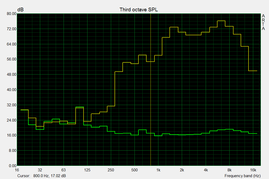
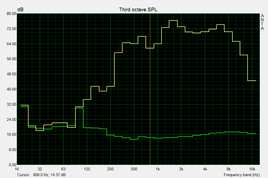
Energy Management
Power Consumption
Power usage is interesting as the Shield shows a power demand below that of other Tegra 4 devices like the HP Slate 8 Pro or Toshiba eXcite Pro AT10LE despite the Nvidia handheld having an active fan. Especially when idle, the Shield draws less power than an idling smartphone. The small and less dense 5-inch display may have a hand in the overall low power consumption. Regardless, maximum load on the Shield is comparable to an average tablet but still higher than smartphones under similar stressful conditions.
Our measurements suggest excellent component hardware and software optimizations by Nvidia to reduce power usage when demands are low and really ramp up speeds when demands are high.
| Off / Standby | |
| Idle | |
| Load |
|
Key:
min: | |
Battery Life
The aforementioned dense and non-removable 28.8 Wh battery allows the Shield to achieve runtimes similar to those of 10.1-inch tablets like the Samsung Galaxy Tab Pro 10.1. When compared to the average tablet in the last six months, our tested WiFi runtime is also definitely above the 541 minute average at 874 minutes (14 hours and 34 minutes).
Heavy use at maximum brightness will drain the battery in about 3.5 hours while standby mode (with screen on lowest settings and disabled WiFi) will not last a day and a half.
For more real-world results, we played GTA 3 at maximum brightness with no system pauses or standby. Under these conditions, we were able to clock in a runtime just shy of 8 hours. For such a powerful handheld, the battery life certainly packs a punch.
Verdict
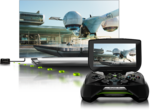
For a first generation Android gaming handheld from Nvidia, the Shield leaves a great first impression right off the bat. The hardware is sound, the battery life is impressive, the controls are comfortable and the display is bright with little ghosting. Based solely on these merits, the Shield can already be considered as one of the best mobile Android gaming platforms in the market.
As with nearly all first generation devices, however, almost every positive comes with a notable negative. The robust hardware is easily scratched in certain areas, the long runtimes come at the cost of a heavy battery, the smaller controls are simply not as large or precise as an Xbox or DualShock counterpart and the display is a downgrade in resolution and color reproduction when compared to high-end smartphones of yesteryear. Its design is also not very practical for simple web browsing or touch-typing. The extent of these hardware disadvantages are only minor to moderate and certainly not significant enough for us to discourage potential buyers from taking a look. In fact, we see the specialized Nvidia software as what makes the Shield stand out from the usual smartphones and tablets.
The recent software updates for GRID cloud gaming, GameStream streaming and the Gamepad mapper cater to the special tactile controls so well that these few features alone make up most of the value of the Shield. The ability to play PC games on-demand alleviates one of Shield's biggest problems - the lack of triple-A titles for Android. The software do have small bugs with GRID still in Beta as of this writing, but the core functionality, infrastructure and performance all generally work as advertised and will only improve overtime. Without these features, existing Android games will likely keep you busy for just a few minutes at a time, something you can already do better on a typical smartphone or tablet.
The recent price drop to $200 and the massive KitKat and software updates all make the Shield very recommendable for PC gamers on-the-go with fast and steady broadband connections. Sure, hardcore gamers will be quick to point out the rough spots in the software and hardware, but we found ourselves too busy enjoying emulated games and streaming PC titles from miles away to really bother.




